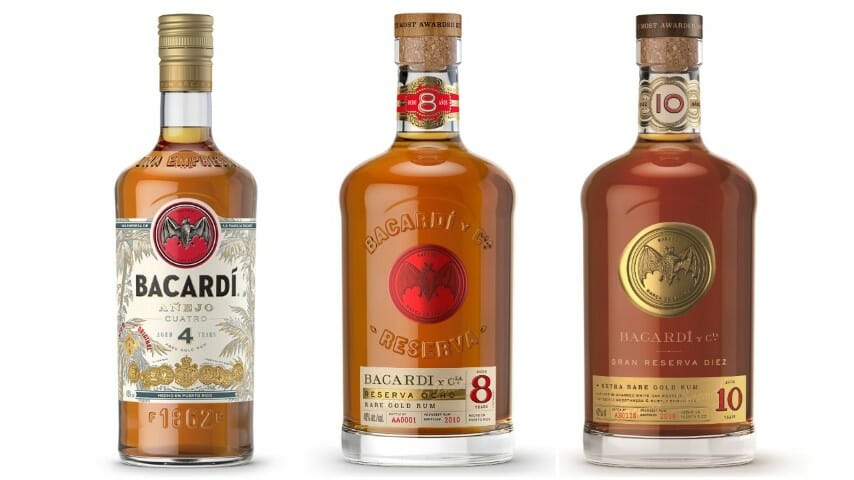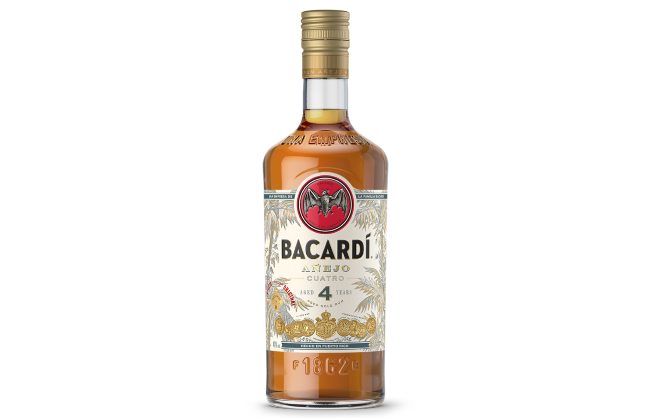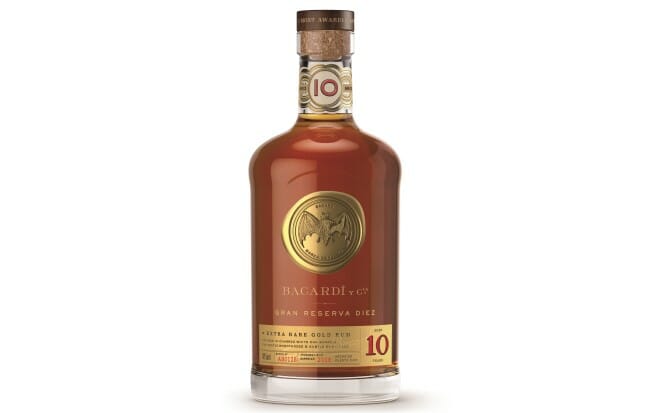
It’s no secret that “serious” rum geeks have a tendency to look straight past the portfolio of Bacardi when it comes to seeking out new tasting experiences. Nor is it surprising—a massive international company (the largest privately held, American-owned spirits company, actually) known for its unaged, inoffensive flagship white rum isn’t the kind of entity that sparks crazy enthusiasm in a community full of devotees for funky, high-ester Jamaican rums or crazy flavorful, earthy rhum agricoles. In contrast, the easygoing, column distilled Spanish-style rums of Bacardi can look a little plain, which can lead to rum geeks never getting around to trying them at all.
That was certainly the case for me, anyway—when I fell hard into aged rum in the last few years, I vaulted straight past the accessible, widely available stuff in a quest to try rum’s more intensely characterful niches. I was dimly aware that there were aged expressions from Bacardi that were fairly popular as high-value offerings in mixology settings, but I was in a rush to drink my way through more interesting locales (to me) such as Barbados and Jamaica.
Suffice to say, I slept on ever sampling these Bacardi aged expressions, but over time, I began to notice how commonly they were utilized at some of my favorite, rum-centric cocktail bars. This is no doubt related on some level to their very approachable price tags, but if bartenders I respect think that the likes of Bacardi Reserva Ocho are worth my time, I’m happy to accede to their far greater degree of knowledge in the field of rum than myself.
What I was surprised to find, looking into these aged Bacardi expressions, was that two of the core lineup—what Bacardi refers to as its “Premium Rum Portfolio”—are still quite new. The venerable Reserva Ocho has been around for quite a while, but the two rums it’s flanked by on either side, Anejo Cuatro and Gran Reserva Diez, were introduced as recently as 2018, in an effort to broaden the company’s aged rum offerings. Their MSRPs form a logical step ladder, with different age-stated bottles available at $20, $30 and $40—a little something for any budget. All are meant to serve as pure, unadulterated and unflavored (at least mostly) expressions of the distillery’s craft.
Now curious, I obtained samples of all three. Let’s see how the 4, 8 and 10-year expressions of Bacardi stack up, shall we?
Bacardi Anejo CuatroPrice: $20

The existence of Anejo Cuatro might not seem to make a lot of sense initially, considering that one of Bacardi’s best-selling products has always been the lightly aged, non-age-stated Bacardi Gold, which carries a rock-bottom price tag of around $10 for 750 ml bottles. Anejo Cuatro, however, represents what is intended to perhaps be a fledgling rum fan’s first expansion into real age statements—a way to drop an extra $10 and be rewarded with the knowledge that you’re drinking something at least four years old, with a modicum of gravitas. It’s a flexible and uncomplicated aged rum, distilled in Puerto Rico (all of these bottles hail from Bacardi’s flagship distillery in Puerto Rico) and bottled at a standard 40% ABV (80 proof).
On the nose, I’m getting some light green apple fruitiness and considerable butterscotch, with cotton candy-like sweetness. It’s somewhat watery on the palate, but also a tad on the hot side for the proof, with an alcohol presence that is slightly punchy. Anejo Cuatro isn’t lacking in flavor, however, with assertive impressions of ginger snaps, clove and molasses cookies. It’s a slightly artificial sweetness, perhaps, but at $20 the only real knock here is a slightly harsh and overt ethanol character. This is more than serviceable as a mixer, however—in fact, compared with a bottle of Mount Gay Eclipse I happened to have on hand, I thought Bacardi Anejo Cuatro actually possessed a more nuanced and ultimately superior flavor profile, which I wouldn’t have expected. There’s no denying it’s a positive upgrade from the non-aged stated bottle of Bacardi Gold you tipped into your Coke in college.
Bacardi Reserva OchoPrice: $30

The MSRP of Reserva Ocho is a pretty approachable $30, but the fact that it can often be found for considerably less—Total Wine is selling it for $23 at the moment!—makes this the real value pick of the lineup, and perhaps one of the best pure values in aged rum. Like the Anejo Cuatro, this is distilled and aged in Puerto Rico, and bottled at the minimum of 40% ABV (80 proof). Reserva Ocho is the longtime flagship of Bacardi’s aged rum portfolio, and is likely the most common bottle in this range that you’ll spot at bars and restaurants. After tasting it, I can see why: This is a rich and versatile cocktail rum that can also stand in for neat drinking, at least for those who don’t mind the lower proof point.
On the nose, there’s thankfully less of an overt ethanol presence here than in the Anejo Cuatro, with more caramel apple in its place, and an inviting waft of baking spices and seasoned oak. There’s slightly more oak and fruit (apricot, plum) on the palate, but the most surprising aspect is just how spicy this rum is—full of sweet cloves, candied ginger, allspice and cinnamon. It’s much more characterful than the Anejo Cuatro, and nicely fills in some of its gaps, with an alcohol presence that is mellowed considerably. It’s still unfortunately thin at the palate at this proof point, and its residual sweetness is beginning to push into syrupy territory, but at $25 or less it’s a pretty outstanding value compared to the valuations on most similarly aged-stated bottles. If you do find it south of $25, I sort of can’t imagine why you wouldn’t buy the Reserva Ocho instead of the Anejo Cuatro—it’s a considerably more developed product, and the difference in price between the two can be almost negligible.
This is, in my estimation, the best bang for your buck in the lineup.
Bacardi Gran Reserva DiezPrice: $40

In terms of extending the Bacardi Premium Rum Portfolio, an extra-aged expression older than the Reserva Ocho only made sense, but one has to wonder right off the bat if a 10-year expression really cuts it. Is a two-year difference between Ocho and Diez really enough, as far as justifying a new product, especially when the strength remains unchanged at 40% ABV (80 proof)? Why not hike this one up to 90 proof, if you really want to premiumize the high-end of this lineup? Even a little boost would likely have helped to differentiate Diez in a way that goes beyond “it has a slightly higher age statement.” But hey, that’s just our opinion. The MSRP of $40 is still pretty decent for any 10 year age-stated rum, although with Reserva Ocho frequently dipping down to the $25 and even below range, it makes this particular $40 mark feel like more of a premium.
On the nose, Gran Reserva Diez is warm and pleasant, with notes of spice cake and ginger snaps. It’s fairly treacly here, suggesting a particularly rich dram, which follows through onto the palate with expressive notes of molasses cookie, baking spices, almond and vanilla. The oak speaks more strongly here, adding a bit more of a drying astringency and some subtle tannins, but all in all the profile of this rum is very much in the mold of the Reserva Ocho—there’s unsurprisingly less variation between two of them than there was between the Anejo Cuatro and the Reserva Ocho. It’s more of a subtle upgrade, still somewhat lacking in terms of its thinner texture, but perfectly pleasant for neat drinking. There are some lovely cocktail applications to be had here, I’m sure, but I’m still left wishing that this particular release could have differentiated itself more fully, perhaps with some kind of unique barrel finish or simply a higher proof point.
Bacardi Gran Reserva Diez is more of a “if you’ve got the coin to drop, go ahead” release. It can’t compete with the pure value that the Reserva Ocho represents, but it’s not breaking anyone’s bank at $40 either.
All in all, I can see why these are popular in restaurants and bars—they’re sweet and approachable, they mix well, and they’re not too funky or challenging. My real takeaway from tasting this lineup is that the Reserva Ocho is a hidden gem, and one I’ll be looking for more often in the future. If you find that bottle on sale, it’s a great value that is ready to be plugged into practically any rum drink.
Jim Vorel is a Paste staff writer and resident liquor geek. You can follow him on Twitter for more drink writing.